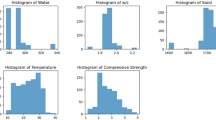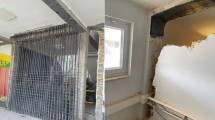Abstract
Models for predicting the reactivity and hot strength of coke are analyzed. The models take account, for example, of the genetic characteristics of the coal and the ash composition. Predictive formulas for CSR and CRI are proposed on the basis of the ash basicity in the coal batch.
Similar content being viewed by others
References
Lyalyuk, V.P., Tovarovskii, I.G., and Tarakanov, A.K., Pulverized-coal injection and alternative blast-furnace technologies, Chern. Metall.: Byul. NTiEI, 2011, no. 11, pp. 20–26.
Tovarovskii, I.G., Bol’shakov, V.I., and Lyalyuk, V.P., Coke-saving technologies: Prospects for blast-furnace development, Metallurg. Gornorud. Prom., 2011, no. 2, pp. 10–13.
Lyalyuk, V.P., Tovarovskii, I.G., Demchuk, D.A., et al., Antratsit i termoantratsit v shikhte domennoi plavki (Anthracite and Thermoanthracite in Blast-Furnace Batch), Dnepropetrovsk: Porogi, 2008.
Shtafienko, N.S., Chevychelov, A.V., Gridasov, V.P., et al., Influence of the reactivity and hot strength of coke on blast-furnace performance, Chern. Metall.: Byul. NTiEI, 2009, no. 3, pp. 29–32.
Kosogorov, S.A., Kogan, L.A., Kaufman, A.A., and Kukolev, Ya.B., Reactivity CRI and hot strength CSR of coke: Measurement methods and relevant factors: A review, Koks Khim., 2006, no. 7, pp. 16–24.
Starovoit, A.G., Information provided by CRI and CSR regarding coke properties, Metallurg. Gornorud. Prom., 2007, no. 4, pp. 13–14.
Nomura, S., Matsuzaki, S., Naito, M., et al., Enhancement of blast furnace reaction efficiency through the use of highly reactive coke, FISTech 2006: Proceedings, 2006, pp. 31–37.
Ujisawa, Y., Nakano, K., Matsukura, Y., et al., Subjects for achievements of blast-furnace operation with low reducing agent rate, Tetsu-to-Hagane, 2006, vol. 92, no. 12, pp. 323–329.
Shimizu, M. and Naito, M., Technological progresses and researches on blast furnace ironmaking in the new century, Tetsu-to-Hagane, 2006, vol. 92, no. 12, pp. 694–702.
Naito, M., Necessity of high strength and high reactivity for coke, CAMP ISIJ, 2007, vol. 20, pp. 620–623.
Lyalyuk, V.P., Tarakanov, A.K., and Kassim, D.A., Influence of the reactivity of coke on blast-furnace performance, Coke Chem., 2011, vol. 54, no. 2, pp. 47–52.
Tarakanov, A.K., Lyalyuk, V.P., and Kassim, D.A., Current approaches to assessing the quality of blast-furnace coke, Steel Transl., 2011, vol. 41, no. 7, pp. 589–593.
Lyalyuk, V.P., Kassim, D.A., Tarakanov, A.K., and Otorvin, O.I., Influence of the hot strength of coke on its blast-furnace consumption, Metallurg. Gornorud. Prom., 2013, no. 3, pp. 37–41.
Bazegskii, A.E., Ryabichenko, A.D., Kudashkin, I.A., and Stankevich, A.S., Relation of the reactivity of coke with the petrographic characteristics of the batch and the coking parameters, Koks Khim., 2001, no. 7, pp. 15–19.
Bulanov, A.E., Zainutdinov, V.N., Kuznetsov, V.Ya., et al., Predicting the hot strength CSR and reactivity CRI of coke, Koks Khim., 2005, no. 5, pp. 23–26.
Bazegskii, A.E., Ryabichenko, A.D., Khamidulin, F.Z., et al., Model for predicting furnace coke characteristics on the basis of the batch characteristics and coking parameters, Koks Khim., 2002, no. 9, pp. 15–22.
Stankevich, A.S., Gillyazetdinov, R.R., Popova, N.K., and Koshmarov, D.A., Model for predicting furnace coke characteristics CSR and CRI on the basis of the batch characteristics and coking parameters, Coke Chem., 2008, vol. 51, no. 9, pp. 357–363.
Miroshnichenko, D.V. and Ulanovskii, M.L., Reactivity of coke: Measurement methods and relevant factors: A review, Koks Khim., 2004, no. 5, pp. 21–31.
Ulanovskii, M.L. and Miroshnichenko, D.V., Influence of the mineral components of coal on coke quality (CSR and CRI), Coke Chem., 2007, vol. 50, no. 4, pp. 94–98.
Ulanovskii, M.L. and Miroshnichenko, D.V., Sulfur in coal and its influence on coke quality and consumption in the blast furnace, Coke Chem., 2008, vol. 51, no. 2, pp. 51–56.
Miroshnichenko, D.V., Preliminary assessment of the CSR and CRI values of coke on the basis of the physical properties of the coal ash, Coke Chem., 2008, vol. 51, no. 11, pp. 447–450.
Ulanovskii, M.L., Optimizing coke quality (CSR and CRI), Coke Chem., 2009, vol. 52, no. 1, pp. 11–15.
Stankevich, A.S. and Bazegskii, A.E., Optimizing coke quality at OAO EVRAZ ZSMK in the light of the available coal, Coke Chem., 2013, vol. 56, no. 10, pp. 364–371.
Author information
Authors and Affiliations
Corresponding author
Additional information
Original Russian Text © V.P. Lyalyuk, V.P. Sokolova, E.O. Shmeltser, D.Yu. Timofeeva, V.V. Beryeza, 2014, published in Koks i Khimiya, 2014, No. 6, pp. 15–22.
About this article
Cite this article
Lyalyuk, V.P., Sokolova, V.P., Shmeltser, E.O. et al. Predicting the reactivity and hot strength of coke on the basis of ash basicity. Coke Chem. 57, 238–244 (2014). https://doi.org/10.3103/S1068364X14060052
Received:
Published:
Issue Date:
DOI: https://doi.org/10.3103/S1068364X14060052




